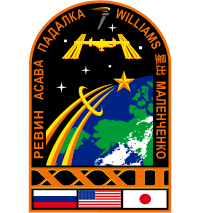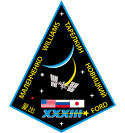Expedition 32
| Expedition 32 | |||
 | |||
| Uppdragsstatistik | |||
|---|---|---|---|
| Rymdstation: | ISS | ||
| Start: | 1 juli 2012, 04:48 UTC[1] | ||
| Slut: | 16 september 2012, 23:09 UTC[1] | ||
| Antal besättningsmedlemmar: | 6 st | ||
| Rymdpromenad | |||
| Antal rymdpromenader: | 3st | ||
| Total tid: | 20 timmar, 36 minuter | ||
| Transport | |||
| Uppskjutning: | med Sojuz TMA-04M, Sojuz TMA-05M | ||
| Uppskjutningsplats: | Kosmodromen i Bajkonur | ||
| Landning: | med Sojuz TMA-04M, Sojuz TMA-05M | ||
| Landningsplats: | Kazakstan | ||
| Kronologi | |||
| |||

Expedition 32 var den 32:e expeditionen till Internationella rymdstationen (ISS). Expeditionen började den 1 juli 2012 då delar av Expedition 31s besättning återvände till jorden med Sojuz TMA-03M .
Sunita Williams, Jurij Malentjenko och Akihiko Hoshide anlände till stationen med Sojuz TMA-05M den 17 juli 2012.
Expeditionen avslutades den 16 september 2012 då Joseph M. Acaba, Gennadij Padalka och Sergej Revin återvände till jorden med Sojuz TMA-04M.
Besättning
| Position | Första delen (1 juli - 17 juli 2012) | Andra delen (17 juli - 16 september 2012) |
|---|---|---|
| Befälhavare | Hans fjärde rymdfärd | |
| Flygingenjör 1 | Hans andra rymdfärd | |
| Flygingenjör 2 | Hans första rymdfärd | |
| Flygingenjör 3 | Hennes andra rymdfärd | |
| Flygingenjör 4 | Hans femte rymdfärd | |
| Flygingenjör 5 | Hans andra rymdfärd | |
Referenser
- ^ [a b] NASA's Space Station Expedition 32 Arkiverad 28 september 2012 hämtat från the Wayback Machine., läst 1 september 2016.
Externa länkar
| |||||||||||||||||||
Media som används på denna webbplats
Thin crescents along the horizons of Earth and its moon depict International Space Station (ISS) Expedition 31. The shape of the patch represents a view of our galaxy. The black background symbolizes the research into dark matter, one of the scientific objectives of Expedition 31. At the heart of the patch are Earth, its moon, Mars, and asteroids, the focus of current and future exploration. The ISS is shown in an orbit around Earth, with a collection of stars for the Expedition 30 and 31 crews. The small stars symbolize the visiting vehicles that will dock with the complex during this expedition.
The Expedition 33 patch depicts the International Space Station (ISS) orbiting around the Earth, and into the future. The national flags of Japan, Russia, and the United States of America represent the crew of Expedition 33, which consists of six astronauts and cosmonauts from Japan, Russia and the United States. The five white stars represent the partners participating in the ISS Program – Canada, European countries, Japan, Russia and the United States. Expedition 33 will continue the work of the previous thirty-two expedition crews on board the multi-national laboratory in areas such as biology and biotechnology, earth and space science, educational activities, human research, physical and material sciences, and technology development and demonstration.
Expedition 32 crew members take a break from training at NASA's Johnson Space Center to pose for a crew portrait. Pictured from the left are Japan Aerospace Exploration Agency (JAXA) astronaut Akihiko Hoshide, Russian cosmonaut Yuri Malenchenko, NASA astronaut Sunita Williams, NASA astronaut Joe Acaba, all flight engineers; Russian cosmonaut Gennady Padalka, commander; and Russian cosmonaut Sergei Revin, flight engineer.
This patch represents the 32nd expedition to the International Space Station (ISS) and the significance of the science being conducted there for current and future generations. The arch shape of the patch symbolizes the "doorway" to future space exploration possibilities. The ISS, an orbiting laboratory above the Earth, provides a unique perspective for Earth observation and monitoring. The flame depicts the pursuit of knowledge and highlights the importance of education as the key to future human space flight. The astronaut symbol circles the Earth, acknowledging the work of all astronauts, past, present, and future. The names of each crew member located on the border of the patch are written to honor the various cultures and languages on the mission. The three flags also depict the home countries of the Expedition 32 crew members and signify the collaborative ISS partnership of 15 countries working as one.






